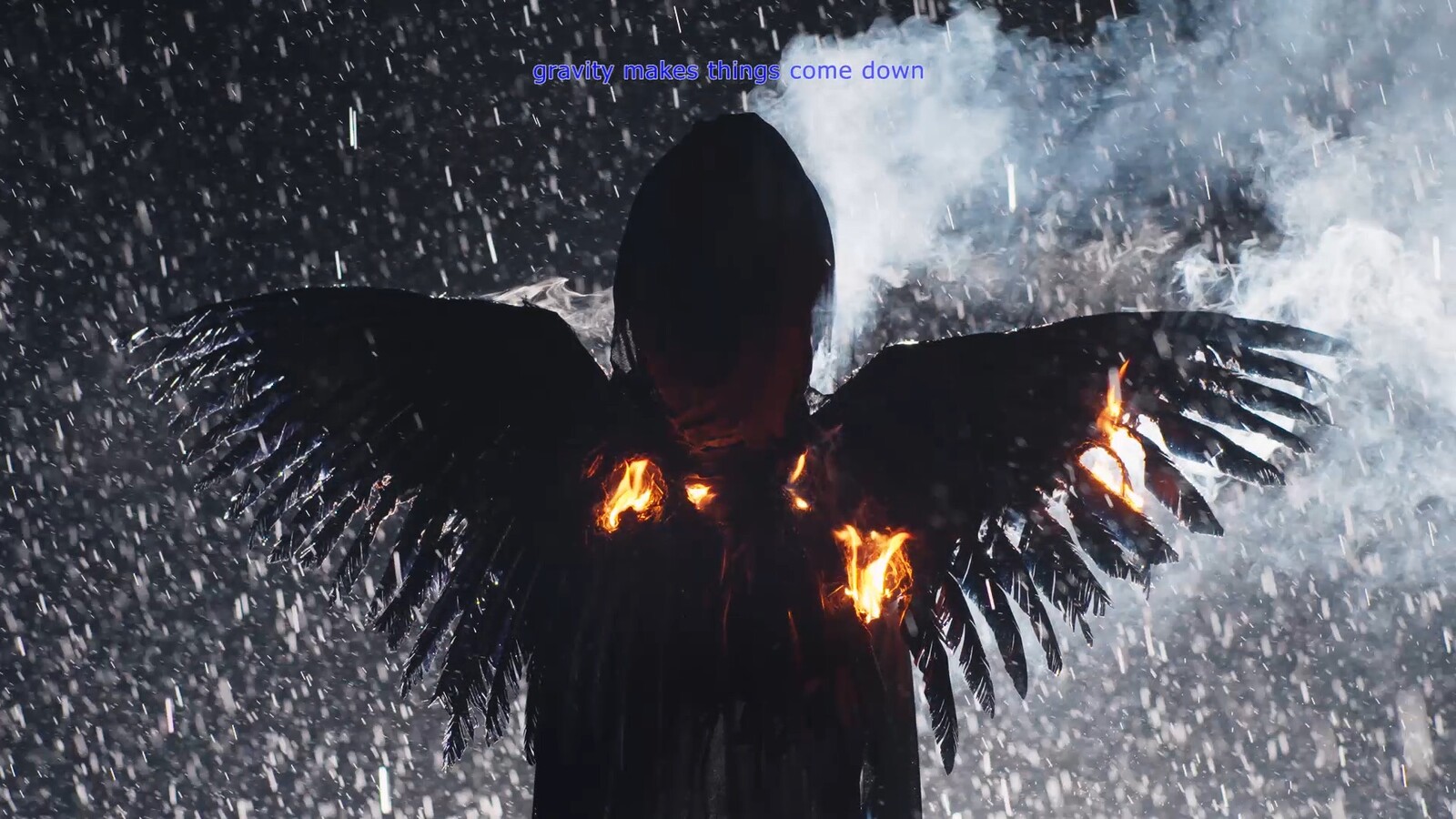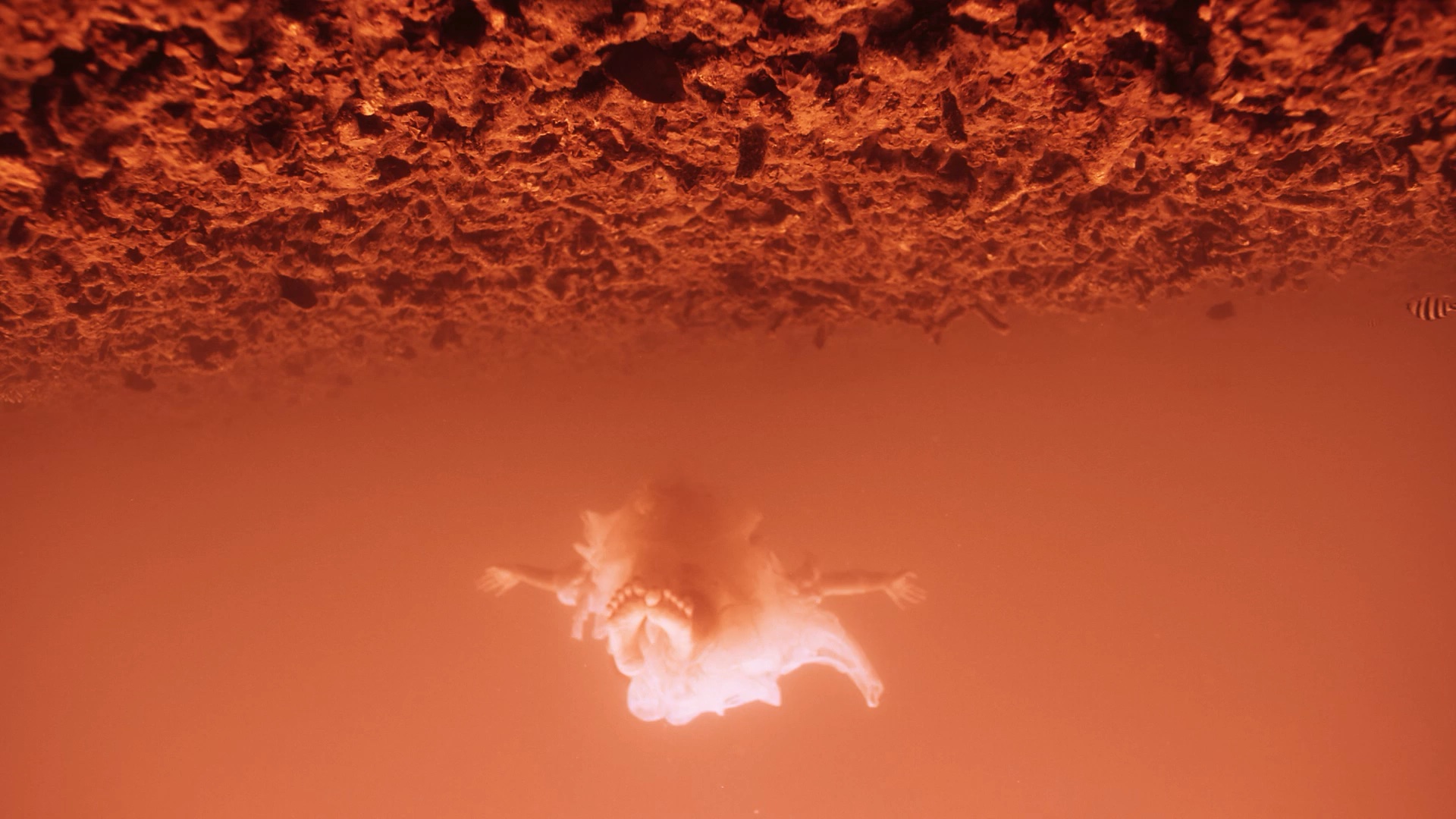
Korakrit Arunanondchai & Alex Gvojic, Songs for living (still), 2021. 20:53min HD Video [courtesy of the artists and Canal Projects, NY]
Korakrit Arunanondchai and Alex Gvojic: PRAY
Share:
Beyond a subtly marked door on Canal Street in Lower Manhattan, Korakrit Arunanondchai and Alex Gvojic have created something akin to an astral portal. PRAY, the artists’ current multimedia installation, is animated by a wash of cerulean light that melts the limits of the confining walls and suspends any conception of time or space. My body’s boundaries, too, were enveloped by this blue glow. A collection of bleached, denim-encased pillows the size of boulders mimics the crescent caveae of Greek and Roman amphitheaters. In the orchestral area, this same denim, scrunched and creased, cradles the circumference of a shallow body of water that Arunanondchai describes as a wishing pond. A figure on the ground supplicates in a prayer-like position. Its back is bent, its hands stretch forward, and its fingers hover slightly above the water’s surface. These hands are cast from Arunanondchai’s grandfather’s. Their animatronic fingers extend and pull—as if plucking the strings of a guitar—and they create ripples that dance toward the pond’s perimeter.
Projected onto the water’s surface and reflected on a grand oval screen—omnipotent in its size—is the 18-minute-long video Songs for living (2021). Quick cuts of a rapid descent down the side of a high-rise building are spliced with images of a bird, charred, in a puddle on flooded soil, engulfed in flames. Hands sweep toward the ground, suggesting rest. Through speakers, frenzied electric guitar strikes clash against the chaotic clang of a high hat. The effect of this score—discordant in its composition—paired with the tangled phantasmagoria of fast video edits feels like life flashing before my eyes. Is this how I die? Just as I feel that I’m about to meet the pavement, the tempo hastens and the camera suddenly ascends the side of the skyscraper and tilts up, toward the sky—a dazzling white, speckled by the silhouettes of circling black birds. “Their bones will turn into coral,” lilts a somber, dragged-out voice. Next, fish weave and dodge moss-bloomed pipelines on a seabed, and, perhaps in this same vicinity, a fleshy heart beats as its blood fuses with an aquatic ecosystem. Blanched figures with viscous, black petroleum seeping from their mouths stand waist-deep in a lake.
Korakrit Arunanondchai & Alex Gvojic, Songs for living (still), 2021. 20:53min HD Video [courtesy of the artist and Canal Projects, NY]
Water and its ecologies permeate the audiovisual lexicon of Songs for living. By speaking about water—and its deepest form, the ocean—Arunanondchai and Gvojic invoke a global history of decaying human and nonhuman beings who haunt the present as marine ecologies. The ocean is the site of the Middle Passage, through which enslaved Africans were forcibly transported across the Atlantic to the New World. Sometimes those Africans were violently thrown overboard—or willingly jumped, in an act of revolt. Those who chose the latter path believed they would join their ancestors in the afterlife. And they are with us still, their bodies consumed by carnivorous sea life that trailed in the wake of those ships—creatures that have themselves decayed, providing life to generations of species around them. The same seas hold bodies of thousands of migrants whose ships faltered on the way to Europe. They joined others, decomposed, falling to the seabed as the residual collateral of European necropolitics. The ocean is life and death in constant circulation.
Korakrit Arunanondchai & Alex Gvojic, Spirit House, installation detail, 2022, wood, LED lighting, glass. [photo: Daniel Kukla; courtesy of the artists and Canal Projects, NY]
Along one side of the gallery, four scratched and charred spirit houses glow, as if with embers. Made in collaboration with Arunanondchai’s mother, these spirit houses are portals through which humans and nonhumans can communicate. Each one’s roof supports two finials that reach pointedly toward the sky. Undulating from the roofs are intricate designs of flowers and filigree that curl, serpent-like, at their ends. Each structure contains remnants of life’s cycles. Petroleum, like that which trickled from the video’s figures, oozes from a ceiling; tiny clear jars contain dark gray pebbles resembling fossils or bones; minuscule replicas of amphibians and mammals gather around an egg cradled in lace. If there were a passage to the afterlife, it would be through here.
Korakrit Arunanondchai & Alex Gvojic, PRAY, installation view, 2022 [photo: Daniel Kukla; courtesy of the artists and Canal Projects, NY]
In a dark nook on the gallery’s lower level is Songs for living’s converse companion, Songs for dying (2021). Organized around a procession of songs, this 30-minute video is a deeply personal collection that entwines stories of loss, mourning, reincarnation, and resilience, all focused upon the passing of Arunanondchai’s grandfather. “Now we will practice dying,” declares a disembodied voice—instructive, yet safe in its silvery tone. A beautiful remembrance unfolds as Arunanondchai documents his grandfather’s life from near death to its aftermath. Progressing through tender embraces during hospital visits and relatives gathered to mourn his life, familial love radiates from Songs for dying’s core.
Personal grief gives way to the communal as clips of Thailand’s recent anti–government protests and footage of the 1948 South Korean Jeju Massacre erupt on the screen. The Jeju Massacre was an act of counterinsurgency, authorized by South Korean president Syngman Rhee and backed by the anti-communist US military to suppress residents of Jeju, who were engaged in opposition to the division of Korea. Unable to discern a communist guerilla from a civilian, the South Korean government and US military killed indiscriminately. At least 30,000 people died in the massacre. In the 50 years that followed, the South Korean government systematically denied that the event had occurred and silenced those who longed for acknowledgment. By braiding moments of personal and collective loss, Arunanondchai and Gvojic refute the institutionalized disappearing of historical and familial traumas by rejecting commonplace understandings of linear timelines, thus allowing the past to rupture the present.
Whereas mourning, to some, may mark the end of a life, in Songs for dying it simultaneously authorizes rebirth into another one: “In this new life, you’re born into a tree,” reads the caption, which continues, “Grow your roots deep into the ground and let this anarchic energy from the earth flow through your body once more.” If Earth’s ecological communities rely upon the perpetual cycle of human and nonhuman death, decomposition, ingestion, and secretion for new forms of life to flourish, then Songs for dying declares: Sympoiesis is survival.
Korakrit Arunanondchai & Alex Gvojic, Songs for living (still), 2021. 20:53min HD Video [courtesy of the artists and Canal Projects, NY]
As I prepare to leave the gallery, I hear the narrator from Songs for living, as if they are crying after me: “There are no longer individuals, but a single body tendered towards its destiny.” This line recalls and contradicts Margaret Thatcher’s claim, during the era when she ushered in neoliberalism in the United Kingdom, that there is no such thing as society, only individual men, women, and families. It wasn’t solely neoliberalism’s insistence on privation, austerity cuts, and deregulation that created the solitary being she invokes. Opening up the free market accelerated capitalism’s sweeping exploitation of the earth’s resources, and alienated humans from nonhuman minerals, critters, and microbes that share this planet in cycles of life and death. Nature, in this configuration, is distilled to material alone. Soon, forms of nonlife will overtake its antipode, and constrict death’s ability to transform dying into living.
PRAY cautions that if we do not acknowledge the myriad ways that we intimately enfold ourselves in life and death with multiple species that constitute the earth, then we willfully accept more of the same: climate catastrophes, mass extinctions, and viral outbreaks. Arunanondchai and Gvojic suggest that committing to Earth’s ongoingness means accepting that death leads not to an end but to another, flourishing life—a life where we are everywhere, in all times.
Sasha Cordingley (she/they) is an arts and culture writer from Hong Kong and the Philippines. Their writing has been featured in Hyperallergic, C Magazine, ART PAPERS, and Dirt.



